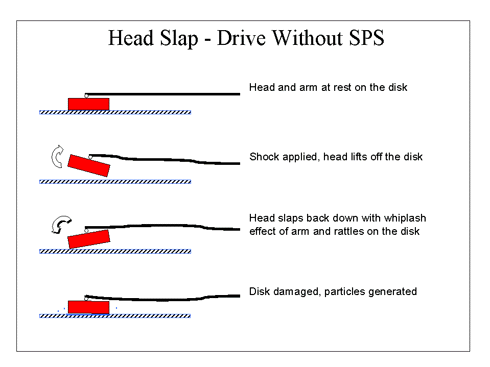[ The PC Guide | Systems and Components Reference Guide | Hard Disk Drives | Hard Disk Performance, Quality and Reliability | Hard Disk Quality and Reliability | Hard Disk Quality and Reliability Features ]
Enhanced Shock Protection
Several major types of drive failures can be caused by excessive shock applied to the drive, especially when it is in operation. This is not surprising, considering the way hard disks work. When you have very precise read/write heads floating a millionth of an inch above the surface of a smooth platter spinning thousands of revolutions per minute, you shouldn't expect that you can give the device rough handling without consequences! When the heads contact the surface of the platters, this is called a head slap and each such event carries the potential for damage or data loss.
Despite the fragility of hard disk technology, we do expect to be able to treat them, well, if not roughly, then at least without kid gloves. We want to put hard disks into laptop computers and carry them around, or use removable drive trays, or incorporate tiny hard disks into devices ranging from handheld PCs to digital cameras. And even with desktop machines, we certainly don't expect the drive to fail if we bump into the case while the PC is on, or similar minor mishaps occur.
To address the increased needs for portability, and to improve reliability and reduce sensitivity to shocks in a general way, hard disk manufacturers have been hard at work improving the shock resistance of drives. One great way to do this would be to basically pack cushioning material around the drive; unfortunately, this would create other problems, ranging from needing to enlarge the drive's form factor, to making cooling more difficult. Therefore, shock protection is primarily done by increasing the rigidity of the most important components in the drive, such as the actuator assembly and spindle motor. To reduce head slap in particular, the head arms are made stronger. Structural support and some cushioning for the disk-head assembly is also provided to help reduce the transmission of shock energy from the outside of the drive to the platters and heads, where damage could occur.
|
Anatomy of a head crash. Shock applied to the drive
causes the heads to lift |
Image � Quantum
Corporation |
Enhanced shock protection is certainly a useful enhancement for drives, and it has been adopted by pretty much every manufacturer in one form or another. If you think about it, this is really a general way of improving the quality of a drive as opposed to a discrete "feature", and all drive makers strive to improve the quality of their units, even if they do it in different ways. Some manufacturers do make more of a "big deal" about this than others.
And by the way, it should go without saying that no amount of shock protection is license to treat your hard drives with anything but the utmost of care!
![]() Next: Fly Height Detection
Next: Fly Height Detection
| The PC Guide
(http://www.PCGuide.com) Site Version: 2.2.0 - Version Date: April 17, 2001 © Copyright 1997-2004 Charles M. Kozierok. All Rights Reserved. |
Not responsible for any loss resulting from the use of this site. Please read the Site Guide before using this material. |
